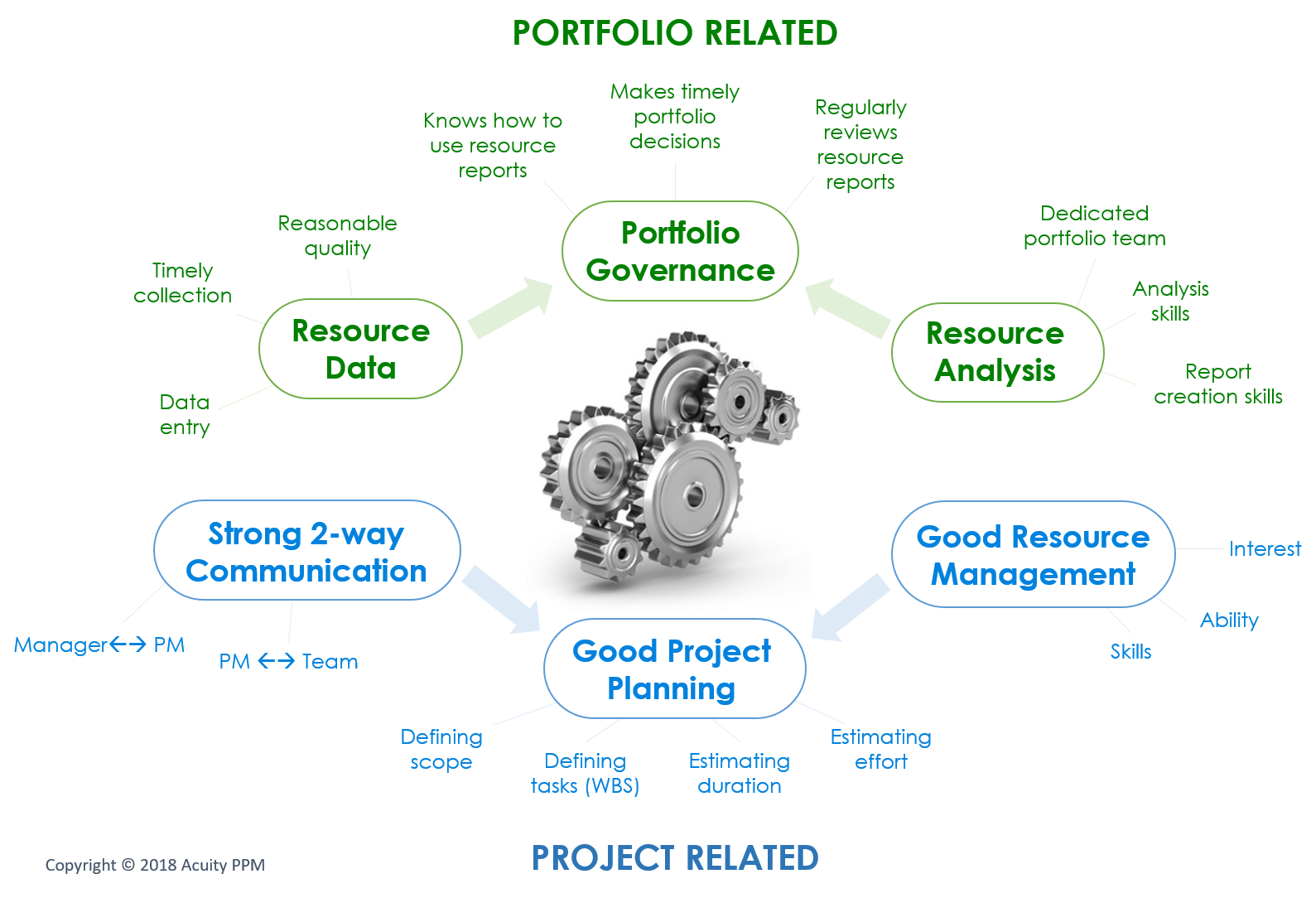Managing useful resource capability is a vital operate of portfolio administration. Organizations generally need to perceive useful resource availability as a result of each firm has a restricted variety of individuals. On paper, managing useful resource capability sounds easy – evaluate useful resource estimates towards accessible time to work. In apply, nonetheless, it’s maybe probably the most difficult self-discipline. On this submit we’ll present an outline of useful resource capability planning and conclude with suggestions for efficiently managing useful resource capability.
What Is Useful resource Capability Planning?
Managing useful resource capability is about evaluating future useful resource utilization of mission assets towards accessible capability to do work. Utilization is the quantity of effort an individual spends on work (mission work, operational work, and so on.) throughout a given period of time. Capability is the usual period of time accessible to do work. As a way to precisely measure utilization and capability throughout the portfolio for every useful resource function we have to know a couple of staple items:
- All of the initiatives within the portfolio
- The forecasted utilization for that function for every mission within the portfolio for a given timeframe (e.g. month-to-month)
- The quantity of non-project work time for that function for a given timeframe (e.g. month-to-month)
- The usual accessible working time for that function (usually 40 hours per week)
Gathering this info for a given useful resource pool is on the coronary heart of useful resource planning and allows us to reply two basic questions:
- When do we’ve capability to tackle new work? (portfolio-oriented)
- Are assets accessible to finish our dedicated work? (mission oriented)
The Portfolio Oriented View of Managing Useful resource Capability
Our first query, “When do we’ve capability to tackle new work?”, is portfolio-oriented in nature to assist senior leaders on a portfolio governance staff perceive when new mission work may be initiated with accessible assets. Understanding useful resource availability informs whether or not new initiatives may be efficiently accomplished on time, on scope, and on price range. If a mission is initiated when there are insufficient assets, it typically requires a few of these staff members to work above their accessible capability or the length of the mission is prolonged requiring further multi-tasking throughout initiatives. Each of those situations ought to be averted. Sadly, probably the most vital mission assets are nearly all the time totally utilized. When there are insufficient assets for a brand new mission, the portfolio governance staff has a couple of choices:
- Add extra assets (typically by means of contractors or hiring new workers)
- Cut back the work of present assets to make them accessible for brand new mission work (typically by cancelling present initiatives or placing initiatives on maintain)
- Cut back the scope of the brand new mission to suit throughout the present availability
- Lengthen the length of a mission to suit throughout the present availability
The Venture Oriented View of Managing Useful resource Capability
The second query, “are assets accessible to finish our dedicated work?”, is a project-oriented view. The main target is on a single mission and whether or not there are any new useful resource shortages or constraints that will forestall the staff from hitting their schedule, scope, and price range targets. The identical useful resource knowledge used to compile the portfolio stage view will also be used to drill right down to a single mission view and provides the Venture Supervisor a sit up for determine potential constraints or useful resource gaps. No Venture Supervisor needs to get stunned by having fewer staff assets than anticipated. Sadly, it occurs far too typically. When a useful resource scarcity happens, the Venture Supervisor has a couple of choices:
- Negotiate with the portfolio governance staff to get the mandatory assets
- Add extra assets (costly and presumably tough to do)
- Revise the scope of the mission
- Lengthen the length of the mission
None of those choices are notably fascinating and ought to be averted.
Easy methods to Handle Useful resource Capability
Primarily based on what we’ve lined to date, you’ll be able to start to see why managing useful resource capability is tough. Now we’ll focus on the right way to acquire the information wanted to handle useful resource capability, beginning with the mission groups. Useful resource capability planning represents the best overlap between portfolio administration and mission administration.
It Begins with the Venture Supervisor
The first knowledge wanted for making a useful resource capability plan are useful resource forecasts for every mission; these forecasts are offered by the Venture Supervisor and are based mostly on useful resource estimates. As quickly as we discuss estimation, it ought to set off a response that the information shouldn’t be going to be 100% correct. That’s proper – useful resource capability planning is predicated on lower than 100% correct info. In reality, each human being struggles with predicting the long run. That’s one cause why managing useful resource capability is tough. The mission useful resource plan is predicated on one of the best estimates from the mission staff, Venture Supervisor, or Useful resource Supervisor, however at greatest, the forecasts are merely estimates.
Estimating is Primarily based on Venture Planning
With regards to useful resource estimating, it’s largely based mostly on the mission staff’s capacity to plan. Venture planning wants to think about:
- Venture scope
- Duties (what must be achieved to finish the mission scope)
- Prices (or effort, typically measured in hours)
- Length (how lengthy will every job take)
- Sources (who’s doing the work)
- Process dependencies (relationships to different actions)
The higher the staff can plan, the higher the useful resource estimates might be.
The Portfolio Supervisor Makes Sense of All of the Knowledge
The job of the Portfolio Supervisor (or portfolio administration staff) is to gather the useful resource knowledge, mixture it, analyze it, and report again to the portfolio governance staff. This function is central because it coordinates throughout mission groups, useful resource managers, and the portfolio governance staff.
**PRO TIP: You’ll want to acquire solely the information that’s actually wanted to handle assets and capability; any knowledge that’s collected however not used to make higher choices is an organizational drain and waste of valuable assets
Managing Useful resource Capability Entails Many Shifting Components
The graphic under highlights the numerous transferring elements of useful resource capability planning each on the portfolio stage and on the mission stage. A breakdown in any of those areas will degrade capability planning; subsequently aligning these course of areas is vital.
On the portfolio stage, we’ve three elements:
- Useful resource knowledge: guarantee well timed and high quality useful resource knowledge
- Useful resource evaluation: requires evaluation and report constructing expertise by a devoted portfolio staff
- Portfolio governance: requires senior leaders within the portfolio governance staff to usually assessment useful resource knowledge, perceive the right way to use the useful resource studies, and make high quality and well timed portfolio choices.
On the mission stage we even have three elements:
- Good mission planning: to make sure scope is outlined, duties are outlined, and estimate length and energy
- Useful resource administration: determine the precise assets wanted in accordance with their expertise, capacity, and curiosity
- Robust communication: guarantee well timed and high quality communication among the many mission staff and all useful resource managers

Challenges with Managing Useful resource Capability
We now have to cowl particular challenges with useful resource capability planning in order that organizations can handle these challenges and achieve success with their capability planning efforts.
Venture Administration Maturity
The power to create a strong mission plan is basically based mostly on the talents and talent of the Venture Supervisor. Good Venture Managers will work with their staff to co-create the mission plan and spend ample time to drill down into the main points. Sadly, many organizations lack the rigor or self-discipline to create good mission plans for all initiatives within the portfolio. That is additional hampered when individuals have the function of ‘Venture Supervisor’ however shouldn’t have formal coaching or management expertise to create a correct plan. This immediately pertains to the mission administration maturity of the group.
Knowledge Granularity
When gathering useful resource forecasts there are various ranges of element {that a} Venture Supervisor can acquire:
- Group: ought to useful resource knowledge be collected at an organizational staff stage? By function? Or by title?
- Timeframe: ought to useful resource knowledge be collected on the quarterly stage? Month-to-month stage? Weekly stage?
- Venture schedule: ought to useful resource knowledge be collected on the mission stage? Part stage? Process stage?
It will be significant for organizations to be clear in regards to the stage of element required to efficiently seize useful resource utilization and capability. The extra granular the information, the extra effort is required to gather and preserve the information.
The Portfolio Governance Group
Surprisingly, senior leaders who’re a part of a governance staff additionally pose a problem to managing useful resource capability. We’ve seen one in all three potentialities:
- Leaders query the information: even when senior management initiates useful resource capability planning, some leaders will query the standard of the information (particularly in the event that they don’t like what the information is telling them). If senior management waits till useful resource knowledge is 100% correct, they’ll by no means use the information.
- Leaders ignore the information: they don’t like what the information is telling them they usually select to disregard it
- Leaders are not sure the right way to use the information: whereas many leaders are robust of their respective areas, some leaders don’t perceive portfolio administration or the right way to handle a portfolio or useful resource capability.
Useful resource Capability Planning Software
One other problem is the right way to acquire and retailer the useful resource knowledge. For quite simple groups, a spreadsheet can be utilized, however it’s nonetheless difficult not solely to enter the information, however much more, to research the information correctly. Venture Managers want one view, Portfolio Managers want one other view, and Useful resource Managers want but a 3rd view. Spreadsheets change into unwieldy when you begin monitoring knowledge throughout a lot of initiatives with a number of roles. Portfolio administration software program is essential for getting the precise views of the information.
The Function of the Useful resource Supervisor
One other problem entails the dynamic between the Venture Supervisor and the Useful resource Supervisor. In some organizations, Venture Managers can specify how a lot time they want for particular assets. In most organizations, a Useful resource Supervisor (the supervisor of a particular staff of individuals) must be consulted earlier than assets are assigned. This requires the Venture Supervisor to barter with the Useful resource Supervisor for the mandatory assets. This provides one other layer of complexity on useful resource capability administration.
Issues Change
The mission surroundings may be very dynamic: the exterior aggressive panorama adjustments, inner management or organizational adjustments happen, individuals depart the corporate, budgets change, strategic objectives shift – all of which have an effect on mission work. The useful resource plan created by the Venture Supervisor is never static for very lengthy. The entire above adjustments may immediate the Venture Group to revisit all of their useful resource forecasts. The extra detailed the useful resource plan is, the extra work that’s required to replace and preserve it as exterior and inner components have an effect on mission work.
The Advantages of Managing Useful resource Capability
There are three basic advantages of managing useful resource capability: a practical workload, optimized use of assets, and organizational morale.
- Lifelike supply: the #1 cause for managing useful resource capability is to create a practical portfolio workload in order that the group can constantly ship initiatives on time. Technique execution is so essential, however when groups are closely over-utilized, it’s almost unattainable to have faith in assembly mission deadlines (assuming that senior management doesn’t set synthetic deadlines). Efficiently managing useful resource capability will tremendously improve the success charges of mission supply.
- Optimized assets: the second main cause for managing useful resource capability is to optimize organizational assets, which suggests to make one of the best use of the restricted assets that you’ve got. When mixed with prioritization, senior leaders can be certain that their most essential individuals are engaged on an important initiatives. That is one other vital success issue for technique execution.
- Organizational morale: lastly, when groups and people are usually not excessively over-utilized, individuals know they’re doing essential work, and sensible plans are set in place, organizational morale will enhance.
Suggestions for Managing Useful resource Capability
In abstract, based mostly on working with many organizations through the years, listed below are a couple of key suggestions:
- Begin with vital assets – don’t attempt to seize useful resource knowledge for each mission staff member. Determine 1-2 roles which might be constantly in excessive demand and start capturing their utilization and capability. This is applicable ideas from the Principle of Constraints to portfolio administration.
- Start with mission stage or section stage estimates – don’t attempt to seize useful resource utilization on the job stage. It sounds nice and is the nirvana of capability planning, however don’t do it. Much less granular knowledge can nonetheless be very helpful for answering the 2 questions at the start of this submit. Part stage estimates are adequate.
- Use the information – senior leaders should start utilizing the information even whether it is lower than good. As quickly as individuals be taught that senior management shouldn’t be utilizing the information, individuals will cease spending time gathering and getting into useful resource knowledge.
- Talk – talk to the group how the portfolio governance staff is utilizing the information. Talk what is anticipated and the way it will assist everybody be extra profitable.
- Assist Venture Managers stage up their mission planning expertise – good capability planning is predicated on good forecasting. Give Venture groups the coaching they should get higher at estimating.
- Don’t begin with time monitoring. Time monitoring has a spot, however shouldn’t be required to do useful resource capability planning. Many well-meaning organizations have gotten caught within the mire of time monitoring with out ever implementing capability planning. Time monitoring appears to be like on the previous, forecasting appears to be like on the future. Time monitoring shouldn’t be a prerequisite for enhancing your forecasting expertise.
Handle Useful resource Capability with Acuity PPM Venture Portfolio Administration Software program
Acuity PPM is a wonderful light-weight mission portfolio administration answer that replaces spreadsheets. Acuity PPM helps you monitor mission efficiency, report mission and portfolio standing to senior leaders, handle and prioritize incoming mission requests, visualize strategic roadmaps, allocate assets and handle useful resource capability. All of this helps allow strategic agility in a altering surroundings. The Acuity PPM useful resource administration module permits you to arrange a useful resource pool, create mission stage useful resource plans, assign staff members, and mixture useful resource knowledge to the portfolio stage.
VIDEO: Useful resource Administration Made Straightforward in Acuity PPM
Tim is a mission and portfolio administration guide with over 15 years of expertise working with the Fortune 500. He’s an knowledgeable in maturity-based PPM and helps PMO Leaders construct and enhance their PMO to unlock extra worth for his or her firm. He is without doubt one of the unique PfMP’s (Portfolio Administration Professionals) and a public speaker at enterprise conferences and PMI occasions.
What Is Useful resource Capability Planning?
Useful resource capability planning is about evaluating future useful resource utilization of mission assets towards accessible capability to do work. This permits corporations to higher handle assets to be able to tackle new work and attain present strategic initiatives.
What’s the distinction between useful resource utilization and useful resource capability?
Utilization is the quantity of effort an individual spends on work (mission work, operational work, and so on.) throughout a given period of time. Capability is the usual period of time accessible to do work.
How ought to I measure utilization and capability throughout the mission portfolio?
1) All of the initiatives within the portfolio 2) The forecasted utilization for that function for every mission within the portfolio for a given timeframe (e.g. month-to-month) 3) The quantity of non-project work time for that function for a given timeframe (e.g. month-to-month) 4) The usual accessible working time for that function (usually 40 hours per week)
What’s the goal of useful resource capability planning?
Managing useful resource capability helps us reply two basic questions: 1) When do we’ve capability to decide to extra work? (portfolio-oriented) 2) Are assets accessible to finish our dedicated work? (mission oriented)



